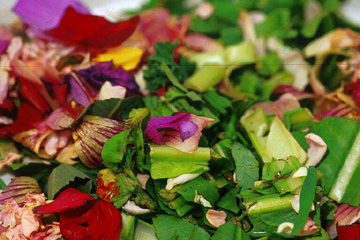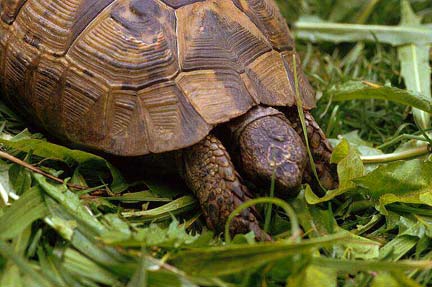
A. C. Highfield
The influence of behavior and digestive biology

The inclusion of 'natural' foods such as flowers in diet is highly recommended as a means of increasing variety and trace element availability - but is not without dangers: it is vital that all ingredients are properly researched.
Different species of animal vary widely in their susceptibilities to individual plant toxins. Most lists of toxic plants presented to reptile keepers are derived from studies (or experiences) based upon humans and commercial livestock. Although such lists are useful, they are by no means entirely reliable when applied to reptiles. These different responses are explained by fundamental differences in diet, by differences in the anatomy and chemistry of digestive tracts, and by differences in feeding behaviors. Certainly, one major factor that influences the effect of ingestion of potentially toxic plant materials is the herbivorous reptiles reliance upon microbial digestion. This is paralleled in mammals by ruminants such as cattle, goats and sheep. Species that utilize a primarily microbial mode of digestion, whether mammalian or reptilian, possess a large fore stomach, or hindgut in the case of reptiles, where toxins become well diluted and are absorbed relatively slowly. The rate of absorption in such species is far slower than in non-ruminants such as pigs, dogs, cats, horses or human beings. Microbial action in the rumen (or hindgut) can also destroy certain toxic plant compounds, although, conversely, it can also have a negative effect by promoting the release of toxic constituents as plant cellular material is degraded.
The most important factors in species differences in plant toxin susceptibility are probably the detoxification mechanisms specific to each species. These mechanisms can even vary within animals of the same species, or between different geographical populations of the same species, e.g., some (but not all) rabbits possess an enzyme known as atropinesterase that counters the effects of deadly nightshade; goats also possess an atropinesterase that makes them less susceptible to poisoning by the same plant. Deer are said to be able to feed on yew and rhododendron, and grey squirrels and American box turtles upon the deadly Amanita mushroom. Galapagos tortoises also consume highly toxic fruits in quantities sufficient to kill a horse. Among lizards, the ground iguanas Cyclura cornuta and C. carinata are known to feed extensively upon the fruits and leaves of the manchineel (Hippomane mancinella) and the fruit of the poisonwood tree (Metopium toxiferum), both of which contain powerful alkaloid toxins (Wiewandt, 1977 and Iverson, 1979).
Although it is commonly assumed that goats can feed with impunity upon almost anything, this is not true. Under natural conditions, the feeding pattern of the flock is determined by its leader, so that identical plants are eaten by all members at the same sites. Flock members learn to avoid the plants actively discriminated against by their leader – goats not kept as a flock, or kids separated from their mothers at an early age show little discrimination and are far more likely to succumb to plant poisoning. It is not known how widely learned toxin avoidance behaviour is in reptiles.

What tortoises may 'know' in the wild, does not necessarily transfer into captive environments; there is good evidence that they will eat toxic plants that are unknown to them.
Poison plant lists often also fail to discriminate between differing toxicity properties of separate plant parts in sufficient detail; it is well known that potato and tomato leaves are inedible, while the fruits and tubers are nutritious – but it is not so often realized that many plants vary in toxicity seasonally, with toxin levels in some plants rising dramatically during episodes of drought. Even altitude can affect toxin levels in some plant species. In nature, the animal’s feeding behavior often varies to accommodate these changes or differences, for example, Dipsosaurus dorsalis consumes only the flowers of the creosote bush (Larea divaricata) and ignores the toxic leaves (Mares and Hulse, 1978). In captivity, however, it is clear that reptiles are not necessarily able to discern dangerous plant toxins if offered unknown varieties – for example, tortoises have died as a result of eating daffodils and green iguanas have died after consuming azalea and oleander - therefore, although “poison plant lists” are technically somewhat inadequate, in practice their use is highly advisable.
Iverson, J. B. (1979) Behavior and Ecology of the Rock Iguana, Cyclura carinata. Ph.D. dissertation, Univ. Florida, Gainsville.
Mares, M. A. and Hulse, A. C. (1978) Patterns of some vertebrate communities in creosote bush deserts. In: Creosote Bush: Biology and Chemistry of Larrea in New World Deserts. Dowden, Hutchinson and Ross, Stroudsburg, Pa.
Wiewandt, T.A. (1977) Ecology, behavior, and management of the Mona Island ground iguana Cyclura stejnegeri. Ph.D. dissertation, Cornell Univ. Ithaca, NY.
© A.
C. Highfield and Tortoise Trust Institute 2002